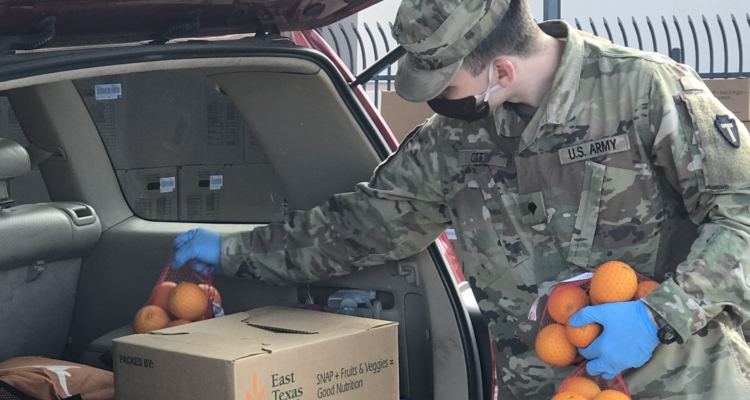by Michael Hetrick
As the COVID-19 pandemic moved closer and closer to home in 2020, the East Texas Food Bank moved quickly into action. Before the pandemic, hunger was already a crisis situation in the twenty-six counties the food bank serves. Nearly 240,000 individuals are facing hunger in East Texas today. That means one in five East Texans, including one in four children, may not know from where their next meal is coming.
“The pandemic hit our most vulnerable neighbors the hardest,” Dennis Cullinane, Chief Executive Officer of the East Texas Food Bank said. “Seniors couldn’t safely go to the grocery store. Hard-working parents had to adapt to their children’s at-home learning and loss of their free and reduced meal programs through school. College students lost their jobs when restaurants and other businesses shut down. We heard so many stories like these from people who had never needed food assistance before the pandemic.”
In order to meet the sudden demand for assistance, the East Texas Food Bank worked diligently supplying more food to families, seniors and children in need. During the pandemic, there was a 74% increase in the number of individuals served. Over 40% had never sought food assistance before.
Drive-thru food distributions were set up in multiple cities to help families receive food in a COVID-safe, organized manner. Senior citizens who were afraid to leave their homes due to the spreading virus could have a box of shelf-stable foods delivered directly to their residence. The Texas Army National Guard worked with the East Texas Food Bank preparing emergency food boxes and distributing them in communities where the need was greatest. The East Texas Food Bank also worked alongside schools to distribute emergency family food boxes during their school lunch distributions.
“The pandemic brought about a heightened awareness of hunger in communities across our nation, Cullinane said. It was that awareness that sparked the attention of a “renowned philanthropist.”
MacKenzie Scott, ex-wife of Amazon founder Jeff Bezos, joined “The Giving Pledge,” a commitment by the world’s wealthiest individuals and families to dedicate the majority of their wealth to giving back. She asked her team of advisors to help her accelerate her 2020 giving through immediate support to people suffering the economic effects of the crisis. They took a data-driven approach to identifying organizations with strong leadership teams and results, with special attention to those operating in communities facing high projected food insecurity, high measures of racial inequity, high local poverty rates, and low access to philanthropic capital.
Her team sought suggestions and perspective from hundreds of field experts, funders, and nonprofit leaders and volunteers with decades of experience. They leveraged this collective knowledge base in a collaboration that included hundreds of emails and phone interviews and thousands of pages of data analysis on community needs, program outcomes, and each nonprofit’s capacity to absorb and make effective use of funding. They looked at 6,490 organizations and undertook deeper research into 822. Of those 822, the team selected 384 organizations to receive funds.
As a result, the East Texas Food Bank received a $9 million donation from Ms. Scott. East Texas Food Bank was one of forty-two food banks selected from Feeding America’s two-hundred-member food banks. “The generous investment in the East Texas Food Bank by Ms. Scott is a vote of confidence in the work we are all doing together to end hunger,” Cullinane said.
At the time of the gift, the East Texas Food Bank was already implementing a strategic plan to increase the number of meals served by 2022 to twenty-eight million meals a year. “Ms. Scott’s gift now gives us the capacity to focus on closing the East Texas meal gap and distribute thirty-two million meals by the year 2025,” Cullinane said.
The new strategic plan, “Feeding Neighbors, Building Community,” contains six key initiatives. The first initiative is expanding capacity of partner food pantries to provide more meal distribution and increase their Supplemental Nutrition Assistance Program outreach and application processes.
The food bank also has plans to bring the resource center model it started with the Deep East Texas Resource Center in Lufkin to other strategic high-need communities like Longview and Texarkana.
“The resource centers contain a healthy pantry and have other wraparound services in collaboration with community organizations that will provide services in a one-stop shop to support families,” Cullinane said. “We want to provide access to food every day to working families.”
Drive-thru distributions will also continue with additional targeted mobile pantries reaching low-income neighborhoods with fresh produce. The funding also allows the East Texas Food Bank to purchase and have available a variety of items for its food pantry partners.
Other key initiatives include working with state and national organizations, like Feeding Texas and Feeding America, to secure high-priority public policy, legislation, and resources to support the collective, long-term goals to end hunger. The East Texas Food Bank also plans to renovate existing workspaces, add new facilities, truck fleet, and additional staffing that will be needed to meet the thirty-two million meal goal by 2025.
“We have the plan together, now it’s time to execute,” Cullinane said, adding that the hunger crisis isn’t something one philanthropist or one gift can solve. “We are going to need public support here in East Texas more than ever to sustain and support our strategic growth. We are enlisting a call to all East Texans to take Ms. Scott’s example and act.”
To support the East Texas Food Bank’s mission to “fight hunger and feed hope in East Texas,” go to EastTexasFoodBank.org and help hungry neighbors who struggle to put food on their tables.


